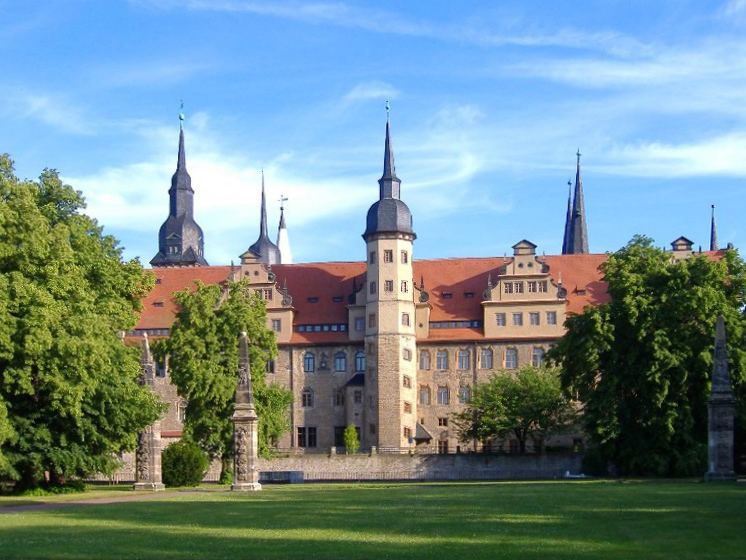Time zone CET/CEST (UTC+1/+2) Population 36,075 (31 Dec 2008) Postal code 06217 | Elevation 88 m (289 ft) Postal codes 06217 Local time Sunday 2:15 PM | |
 | ||
Weather 12°C, Wind SW at 16 km/h, 89% Humidity University Merseburg University of Applied Sciences | ||
Merseburg ([ˈmɛɐzəbʊrk]) is a town in the south of the German state of Saxony-Anhalt on the river Saale, approx. 14 km south of Halle (Saale). It is the capital of the Saalekreis district. It had a diocese founded by Archbishop Adalbert of Magdeburg. The University of Merseburg is located within the town. Merseburg has around 33,000 inhabitants.
Contents
- Map of Merseburg Germany
- Names
- Annexations
- Pre history and Middle Ages
- 17th century to 20th century
- Demographics
- Attractions
- Arts and culture
- Town twinning
- Notable people
- References
Map of Merseburg, Germany
Names
Annexations
Venenien was annexed into Merseburg on 1 January 1949. The parish Kötzschen followed on 1 July 1950. Since 30 May 1994, Meuschau is part of Merseburg. Trebnitz followed later. Beuna was annexed on 1 January 2009. Geusa is a part of Merseburg since 1 January 2010.
Pre-history and Middle Ages
Merseburg was first mentioned in 850. King Henry the Fowler built a royal palace at Merseburg; in the 933 Battle of Riade, he gained his great victory over the Hungarians in the vicinity.
Thietmar of Merseburg, appointed in 973, became the first bishop of the newly created bishopric of Prague in Bohemia. Prague had been part of the archbishopric of Mainz for a hundred years before that. From 968 until the Protestant Reformation, Merseburg was the seat of the Bishop of Merseburg, and in addition to being for a time the residence of the margraves of Meissen, it was a favorite residence of the German kings during the 10th, 11th and 12th centuries. Fifteen diets were held here during the Middle Ages, during which time its fairs enjoyed the importance which was afterwards transferred to those of Leipzig. Merseburg was the site of a failed assassination attempt on Polish ruler Bolesław I Chrobry in 1002. The town suffered severely during the German Peasants' War and also during the Thirty Years' War.
17th century to 20th century
From 1657 to 1738 Merseburg was the residence of the Dukes of Saxe-Merseburg, after which it fell to the Electorate of Saxony. In 1815 following the Napoleonic Wars, the town became part of the Prussian Province of Saxony.
Merseburg is where the Merseburg Incantations were rediscovered in 1841. Written down in Old High German, they are hitherto the only preserved German documents with a heathen theme. One of them is a charm to release warriors caught during battle, and the other is a charm to heal a horse's sprained foot.
At the beginning of the 20th century, Merseburg was transformed into an industrial town, largely due to the pioneering work done by Carl Bosch and Friedrich Bergius, who laid down the scientific fundamentals of the catalytic high-pressure ammonia synthesis from 1909 to 1913. Enterprises, too, blazed a trail in the course of the transformational process. Ultimately, a chemical park emerged at nearby Leuna which is one of the most modern sites of its kind in Europe with high ecological standards.
Merseburg was badly damaged in World War II. In 23 air raids 6,200 dwellings were completely or partly destroyed. The historic town centre was almost completely destroyed.
Briefly part of Saxony-Anhalt after the war, it was then administered within the Bezirk Halle in East Germany. It became part of Saxony-Anhalt again after reunification of Germany.
Demographics
Like many towns in the former East Germany, Merseburg has had a general decline in population since German Reunification despite annexing and merging with a number of smaller nearby villages.
Population of Merseburg (from 1960, population on 31 December, unless otherwise indicated):
Data source from 1990: Statistical Office of Saxony Anhalt
1 29 October
2 31 August
3 3 October
4 14 July 2008
Attractions
Among the notable buildings of Merseburg are the Merseburg Cathedral of St John the Baptist (founded 1015, rebuilt in the 13th and 16th centuries) and the episcopal palace (15th century). The cathedral-and-palace ensemble also features a palace garden (Schlossgarten).
Other attractions include the Merseburg House of Trades with a cultural stage and the German Museum of Chemistry, Merseburg.
Arts and culture
The Merseburg Palace Festival with the Historical Pageant, the International Palace-Moat Concerts, Merseburg Organ Days and the Puppet Show Festival Week are events celebrated every year.
Town twinning
Merseburg is twinned with:
